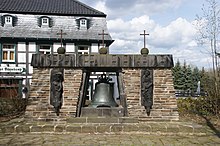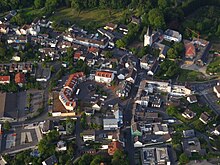Oberpleis
|
Oberpleis
City of Koenigswinter
Coordinates: 50 ° 42 ′ 36 ″ N , 7 ° 16 ′ 40 ″ E
|
||
|---|---|---|
| Height : | 144 (125-180) m above sea level NHN | |
| Residents : | 8750 (Dec. 31, 2019) | |
| Incorporation : | 1st August 1969 | |
| Postal code : | 53639 | |
| Area code : | 02244 | |
|
Location of Oberpleis in North Rhine-Westphalia |
||
Oberpleis is a district of Königswinter , which lies on the side of the Siebengebirge in the Pleiser hill country facing away from the Rhine . The Oberpleis district with the surrounding towns has 8,750 inhabitants, the district itself 4,224 (as of December 31, 2019), making it one of the largest in Königswinters. Due to the proximity to Bonn , the location on the federal highway 3 and the proximity of the forest and nature reserve Siebengebirge , Oberpleis has been a residential area that has been growing for years.
history
Fronhof and Propstei
The Oberpleiser Fronhof , the nucleus of the place, was probably created at the time of the clearing in the 8th and 9th centuries. Oberpleis was first mentioned in a document in 859 as Pleisa superior . The tenth district established in 948 roughly corresponded to the area of the later municipalities of Oberpleis and Aegidienberg .
The oldest religious institution in the Pleiser Hügelland was the St. Cassius Abbey in Bonn . The manor of the Oberpleis with its own church was assigned to the newly founded abbey of Siegburg by Archbishop Anno II of Cologne around 1060, probably from the possession of the Palatine . Before 1105, the Siegburger Propstei Oberpleis with Fronhof was founded, which was able to establish its own sovereignty in the 12th century with the confirmation of jurisdiction in 1182. She chose the Counts von Berg as governors . The provost church of St. Pankratius , built at the beginning of the 12th century, suffered damage during the succession dispute. For better financial resources, the parish was subordinated to the provost with its income in 1206. The building work in the first half of the 13th century included a complete redesign of the church, which led to a high level of debt.
The abbot of Siegburg was the sovereign until 1450, when the Duke of Berg succeeded him. The parish Oberpleis belonged to the office of Blankenberg from then until 1806 and was composed of five honors : "Alte Honschaft" (Oberpleis with Frohnhardt ), Berghausen , Hasenpohl , Oberhau (in the 17th century emerged from the two honors Gratzfeld and Eudenbach ) and Wahlfeld .
Monastic life deteriorated in the late Middle Ages, and by the 16th century at the latest only the provost lived in the buildings. In the course of the Jülich-Klevian succession dispute and in the Thirty Years War , foreign troops looted Oberpleis in 1615 and 1632. During the War of the Spanish Succession (1701–1714), French troops invaded Oberpleis in 1703 and dragged the provost to Bonn.
In the secularization of 1803 the provost fell to the state, which left the provost church of St. Pankratius to the parish as a parish church in 1805. The old parish church was demolished in 1820.
The Oberpleis community from 1816 to 1969
The municipality Oberpleis belonged from 1816 to 1969 to the mayor's office Oberpleis (from 1927 "Amt Oberpleis") in the Siegkreis . In 1841 the seat of the mayor's office was moved from Oberpleis to Stieldorf . 1845/1846 communities were Berghausen , rabbits Pohl , Oberhau , Oberpleis and choice field with the introduction of a new municipal code to the newly formed, politically independent village Oberpleis incorporated.
According to the results of the 1885 census , the municipality of Oberpleis had an area of 3577 ha , of which 1978 ha were arable, 251 were meadows and 1115 were forest. In 1885, the municipality comprised 63 places with 814 residential buildings (including uninhabited ones), in which 3693 inhabitants (1841 men and 1852 women) lived in 778 households. In addition to 3652 Catholics, there were 28 evangelical and 13 Jewish citizens.
In addition to Oberpleis, the localities included Auel, Bellinghausen , Bellinghauserhof, Bellinghauserhohn, Bennerscheid , Bennerth, Berghausen , Blankenbach, Bönnschenhof , Boseroth, Busch, Dahlhausen, Eisbach , Elsfeld , Eudenbach , Eudenberg, Faulenbitze, Freckwinkel , Frohnhardt , Gratzfeld , Grengelsbitze, Hartenberg , Hasenboseroth , Herresbach , Hünscheid (Höhnscheid), chicken Berg, Jüngsfeld , cap Bungert, Kellersboseroth, tilting Hohn, Kochenbach , Comp, Kotthausen, cures Berg, Limperich (sberg) Mettelsiefen, low-Buchholz, Nonnenberg , Pleiserhohn , Pützbroichen, Pützstück, Quirrenbach , rust rings , Rübhausen , Ruttscheid , Sand , Sandscheid , Sassenberg, Schneperoth, Schwirzpohl , Siefen, Sonderbusch, Steinringen, Thelenbitze , Thomasberg , Uthweiler , Wahlfeld , Waschpohl, Weiler, Wiese and Willmeroth .
In 1967 Oberpleis had 8,695 inhabitants, of whom 536 worked in agriculture and forestry, 1,538 in manufacturing and 1,051 in the service sector. 1,425 outbound commuters were compared to 325 inbound commuters. 704 people were employed in 18 industrial companies. In 1967 there were public institutions: 5 elementary schools, a secondary school, an outdoor swimming pool, 3 sports fields, 3 gyms, a kindergarten and 5 libraries.
On August 1, 1969, Oberpleis was incorporated into the city of Königswinter.
Population development
| year | Residents |
|---|---|
| 1816 | 2919 |
| 1843 | 3822 |
| 1871 | 3623 |
| 1905 | 4247 |
| 1961 | 7048 |
Economy and Infrastructure
The economy of both the municipality and the Oberpleis office was shaped by agriculture well into the 20th century. At the end of the 19th century tree nurseries were established that were known far beyond the region and abroad. There were several basalt quarries in the area. The construction of the road from Niederdollendorf to Kircheib in 1853 gave Oberpleis a better connection to the Rhine Valley and the road from Frankfurt to Cologne (today's federal highway 8 ) that crosses the heights . In 1910, 4446 inhabitants were registered in the municipality of Oberpleis.
The Niederpleis -Oberpleis line of the later Rhein-Sieg-Eisenbahn (RSE), which opened in 1893 and was extended a year later to Herresbach and in 1902 to Rostingen, was primarily used to transport the basalt away . The region had a connection to the state railway via this private railway. Passenger traffic, which was not in the first place anyway, declined in the course of the 20th century with the increased expansion of bus routes. In 1962 the RSE finally closed the entire line.
The Oberpleis school center was built from 1971 to 1980 , originally with a three-tier secondary school and a four-tier grammar school . The Hauptschule and Realschule are being phased out, a new integrated comprehensive school is being set up. The facility also includes an auditorium, two gyms and an indoor swimming pool, which has since been replaced by an in-school cafeteria and a self-study center.
The Siebengebirge leisure center was founded in 1935 as a lido at Lützbach and was called the Oberpleis lido until 1984.
Associations and associations
Local associations, clubs and church organizations include:
- German Scout Association Sankt Georg (DPSG), trunk Oberpleis
- TuS 05 Oberpleis
Personalities
- Axel Bellinghausen (* 1983), professional footballer
- Peter Buchholz (1888–1963), prison chaplain, prelate, honorary citizen
- Joachim Hartung (1948–2014), mathematician and professor of statistics, Thomas L. Saaty Prize winner
- Werner Heinen (1896–1976), biologist and writer
- Hans Bernhard Wichert (1897–1967), pastor, honorary citizen
- Heinrich Raderschall (1916–2010), garden architect, born in Oberpleis
- Jeannine Michaelsen (* 1981), presenter and television actress
- Lothar H. Wieler (* 1961), President of the Robert Koch Institute
literature
- 1000 years of the Oberpleis festival week 18. – 26. September 1948, Festschrift; therein: Chronicle of the war and post-war period by Pastor Hans Wichert (pp. 97–109).
- W. Bieroth: The Propstei Church in Oberpleis - a Romanesque monument on the edge of the Seven Mountains, Oberpleis no year (approx. 1950).
- Robert Flink: The history of Oberpleis from the beginning to the loss of the sovereignty of the provosts of Oberpleis to the bailiffs, the dukes of Berg , around 1500, Siegburg 1955.
- Willibald Raabe: Das Hochkreuz von Oberpleis, in: Der Weinberg 62 (1961), pp. 74-75.
- Robert Flink: The former Benedictine Provosty St. Pankratius in Königswinter-Oberpleis , Cologne 1st edition 1982, 3rd edition 1989. ( as PDF )
- Karl Hermann Uhlenbroch: Life in and around Oberpleis. Interesting facts about the Oberpleiser Hügelland , Siegburg 1995.
- Christian Hillen (ed.): Oberpleis economic life since 1850 . Festschrift for the 50th anniversary of the Oberpleis advertising district, Königswinter 2002.
- Karl Josef Klöhs: Kaiserwetter am Siebengebirge , Königswinter 2003.
- Ansgar S. Klein: Former provost church St. Pankratius Königswinter-Oberpleis, Regensburg 2008. ISBN 978-3-7954-6421-9
Individual evidence
- ↑ a b without secondary residences ; Population statistics of the city of Königswinter (PDF)
- ↑ a b c Der Rhein-Sieg-Kreis , publisher: Oberkreisdirektor Paul Kieras, Stuttgart 1983, ISBN 3-8062-0289-3 , p. 277.
- ^ Wilhelm Crecelius , Woldemar Harleß (ed.): Journal of the Bergisches Geschichtsverein , Volume 20, 1884, p. 130.
- ^ Wilhelm Fabricius : Explanations of the historical atlas of the Rhine province, 2nd volume: The map of 1789. Bonn 1898, p. 311.
- ↑ Official Journal for the Cologne District , 1841, page 11
- ^ Fr. Halm: Statistics of the administrative district of Cöln , Boisserée, 1865, S. ( Online Google Books )
- ↑ a b c Community encyclopedia for the Kingdom of Prussia , Volume XII Provinz Rheinland, Verlag des Königlich Statistischen Bureaus (Ed.), 1888, pp. 118/119 ( Online digitalis.uni-koeln.de )
- ^ Resident address book of the Siegkreis 1910
- ↑ Martin Bünermann: The communities of the first reorganization program in North Rhine-Westphalia . Deutscher Gemeindeverlag, Cologne 1970, p. 84 .
- ↑ Census results from 1816 to 1970 of the cities and municipalities. Contributions to the statistics of the Rhein-Sieg-Kreis, Vol. 17, Siegburg 1980, pp. 62–63.
- ↑ Municipal directory 1900 - Siegkreis
- ^ Ingeborg Flagge : Architecture in Bonn after 1945: Buildings in the federal capital and its surroundings . Verlag Ludwig Röhrscheid, Bonn 1984, ISBN 3-7928-0479-4 , p. 156.
- ↑ www.dpsgoberpleis.de
- ↑ www.tus05-oberpleis.de
- ↑ Volker Wichert: Pastor Hans (Bernhard) Wichert, 1897-1967. Retrieved December 25, 2018 (private website).
- ↑ Hansjürgen Melzer: Interview with RKI boss Lothar Wieler: “We must not underestimate this virus”. In: General-Anzeiger . April 6, 2020, accessed April 7, 2020 .






